The increasing emergence of counterfeit prescription drugs is of high concern for the pharmaceutical industry. These drugs are mislabeled to look genuine and/or fraudulently manufactured. These drugs often contain highly dangerous or potent ingredients and no active pharmaceutical ingredient (API)1,2.
The counterfeit drugs are typically made to look like the authentic prescription drug (Figure 1a). It was recently discovered that a fake Xanax containing opioid fentanyl, which is highly potent, was responsible for several overdoses in the US.3 Therefore, it is essential to develop techniques that can rapidly detect the identity of a suspected fake drug.
Due to the low concentrations of APIs found in pharmaceutical drugs, standard Raman spectroscopy may not be sensitive enough for the purpose of detecting API on the pill surface.
This article discusses a surface-enhanced Raman spectroscopy (SERS)-based methodology to identify low doses (<0.2% w/w) of the API alprazolam present in a Xanax pill using a hand-held Raman spectrometer. The pill could be a suspected fake if SERS peaks typical of alprazolam are not observed from the Xanax tablet. The technique shows that SERS can rapidly identify the presence of alprazolam in the pill for anti-counterfeiting purposes.
Xanax
One of the prescription pharmaceutical drugs with alprazolam as the API is Xanax (Figure 1b). Xanax is prescribed for treating panic and anxiety disorders. Usually, a Xanax tablet consists of alprazolam in concentrations of 0.25 mg, 0.5 mg, 1 mg, or 2 mg. The inactive ingredients, or excipients, are a composite of corn starch, cellulose, lactose, docusate sodium, magnesium stearate, sodium benzoate, and silicon dioxide.4
Fentanyl
Fentanyl (Figure 1c) is a synthetic opioid medication. It is considered the most potent painkiller available on the market (with 50 to 100 times more potency than morphine5), and is prescribed to manage pain or as an anesthetic drug for preventing post-surgery pain or other medical treatments.
Fentanyl is also increasingly made illicitly and sold as Xanax or heroin on the streets, resulting in an increase in fentanyl-overdose deaths. As fentanyl is highly potent, drugs containing fentanyl are commonly available in salt forms such as fentanyl citrate or acetyl fentanyl.

Figure 1. Genuine and fake Xanax tablets containing the chemicals (b) alprazolam (API in Xanax) and (c) fentanyl, respectively
Experiment
Raman spectroscopy was used to identify the low dose of alprazolam in a Xantax tablet. In order to verify the method, a B&W Tek TacticID hand-held Raman spectrometer with a 785-nm laser excitation feature and a TacPac adaptor for SERS samples (Figure 2) was used.
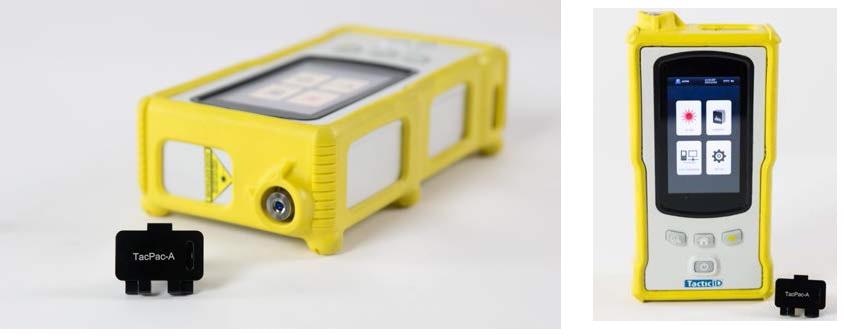
Figure 2. TacticID handheld Raman spectrometer with 785-nm laser excitation and TacPac adaptor
For the purpose of testing, a purchased Xanax pill containing 0.25 mg of alprazolam and fentanyl sourced from confiscated lab-confirmed samples were used. A 2.0 mL plastic centrifuge tube was filled with about ¼ of the Xanax pill (weighing about 30 mg). Then, acetone measuring 0.5 mL was added to the tube.
To dissolve the sample and make the solution look cloudy, the centrifuge tube was shaken. The paper-based SERS substrate was dipped into the dissolved solution for about 30 seconds to enable adequate interaction with the solution and the sample. The substrate was shifted to a TacPac adaptor for analyzing with the TacticID.
To account for sample heterogeneity in the SERS active region, at least three different sports were analyzed on each SERS substrate. The time for automated integration for the scans was in the range of 15 to 30 seconds.
Test Results
Direct Raman Measurement of Xanax
Raman spectrum acquired directly from the Xanax surface (a) which was overlaid with the Raman spectrum of lactose (b) is shown in Figure 3. The Raman peaks observed at several places, 356 cm-1, 436 cm-1, 476 cm- 1, 1088 cm-1, 1120 cm-1, and 1264 cm-1 in spectrum (a), were found to be consistent with lactose.
Peaks consistent with alprazolam were not observed in the spectrum from the tablet surface. It was observed that a direct hand-held Raman measurement is unable to detect the active ingredient present in Xanax from the tablet surface as direct measurement of the Xanax tablet on the TacticID returned a spectral correlation to lactose with an HQI of 86.7.
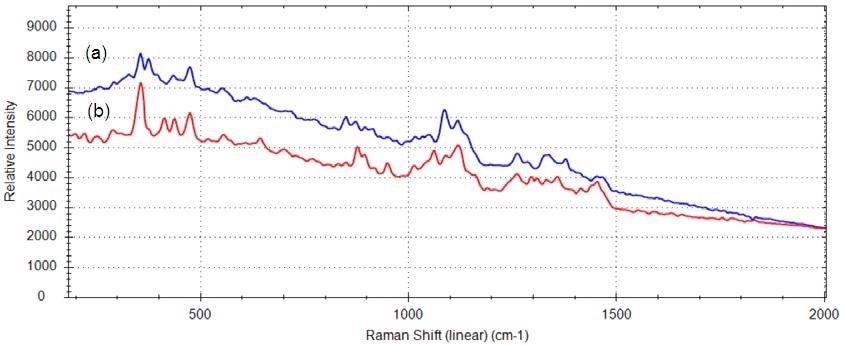
Figure 3. Spectra from (a) direct hand-held Raman measurement of Xanax tablet and (b) direct hand-held Raman measurement of lactose
Detection of Alprazolam in Xanax
In Figure 4, the Raman spectrum of pure alprazolam (a) and the SERS spectrum acquired from Xanax (b) are presented. The SERS peaks observed at 688 cm-1, 1000 cm-1, 1132 cm-1, 1160 cm-1, 1312 cm-1, 1380 cm-1, 1484 cm-1, 1568 cm-1 and 1592 cm-1 are consistent with the Raman spectrum of pure alprazolam.
Typical SERS spectra acquired from Xanax excipients (lactose, cellulose, magnesium stearate, and corn starch) are shown in Figure 5. As the excipients have low solubility in acetone, characteristic Raman patterns from these materials were not observed in the Xanax SERS spectrum.
The SERS substrate adequately improves the Raman signal, although alprazolam is only <0.20% (w/w) of the Xanax pill. This improvement in the Raman signal enables obtaining the signal consistent with the API despite the large concentrations of the excipients in the tablet. This demonstrates the technique’s high selectivity for the alprazolam API and how SERS tests of the sample on the substrate can detect low-doses alprazolam.
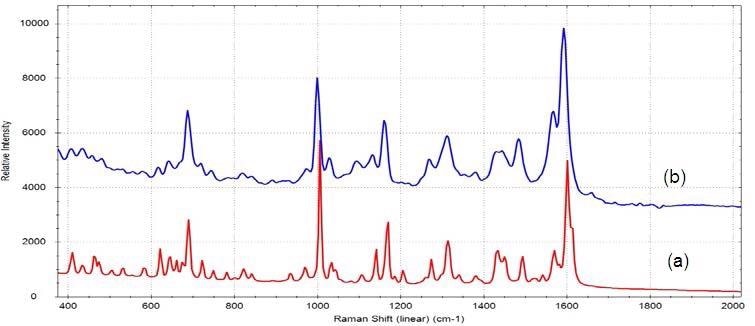
Figure 4. (a) Raman spectrum of pure alprazolam and (b) SERS spectrum from Xanax
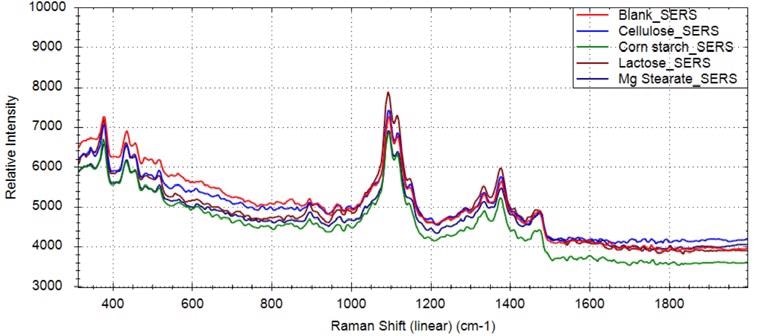
Figure 5. SERS spectra of a blank substrate, cellulose, corn starch, lactose, and Mg stearate
Detection of Fentanyl
The SERS technique was also used to detect fentanyl, as it is usually replaced for alprazolam in fake Xanax pills. The SERS spectrum from a fentanyl sample is shown in Figure 6a. Common to the SERS spectra for alprazolam and fentanyl are a strong peak at 1000 cm-1 allocated to the ring-breathing mode and a small peak at 1029 cm-1.
Figure 6b shows the alprazolam signal from Xanax having peaks at 688 cm-1, 1480 cm-1, 1568 cm-1, and 1592 cm-1. These peaks were not observed in the fentanyl spectrum. Despite common peaks, alprazolam and fentanyl can be differentiated spectroscopically with a suitable algorithm. For anti-counterfeiting purposes, a Xanax pill is deemed as a suspected fake when peaks consistent with alprazolam are missing in the SERS spectrum.
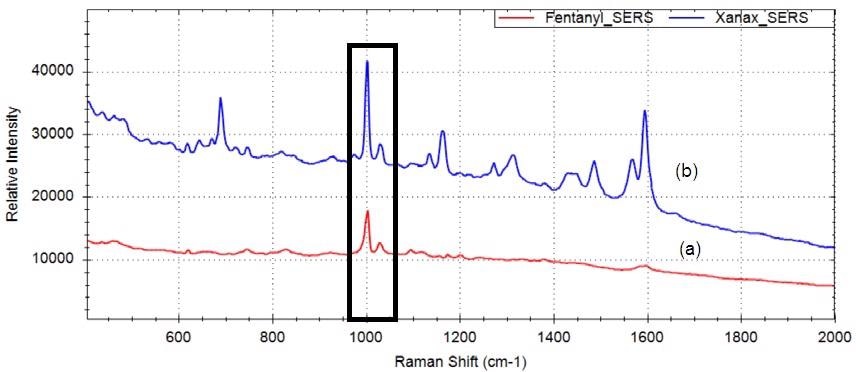
Figure 6. SERS spectra of (a) fentanyl and (b) Xanax
Identification of Xanax
In order to detect an unknown spectrum against a library spectrum, a correlation coefficient algorithm was used for the purpose of making a spectral comparison. The correlation coefficient hit quality index (HQI) for unidentified scans compared to the library spectrum is calculated. This calculation is carried out using the least square dot product of mean-centered unidentified spectrum and the library spectrum, and is represented by:
(Library.Unknown)2
HQI = ---------------------------------------------------------- x 100
(Library.Library) (Unknown.Unknown)
HQI values vary from 0 to 100, with a perfect match represented by 100. Table 1 shows the average HQI correlation to a library spectrum for three unidentified scans of Xanax ingredients and fentanyl.
Table 1. Matching Results
| Material |
Result & Average HQI (n=3) |
| Fentanyl |
Match to Fentanyl (HQI=82.33) |
| Xanax |
Match to Alprazolam (HQI=91.00) |
| Lactose |
No match |
| Cellulose |
No match |
| Mg stearate |
No match |
| Corn starch |
No match |
Conclusion
For the purpose of detecting low concentrations of alprazolam in a Xanax tablet, a SERS-based technique was developed. The technique shows high selectivity for alprazolam in the Xanax pill despite the very low dose. A hand-held TacticID Raman spectrometer loaded with software distinguished the API alprazolam SERS spectrum and the Xanax excipients spectra.
For the purpose of anti-counterfeiting, the Xanax pill is deemed fake if peaks typical of alprazolam are not observed in the SERS spectrum from the pill. The TacticID can also identify the SERS fentanyl spectrum, enabling fentanyl detection if used as a substitute for alprazolam.
Field officers can easily prepare the sample to perform the SERS analysis. Rapid identification of alprazolam’s presence in a Xanax pill or the presence of fentanyl and other such potential harmful elements is an important tool for the pharmaceutical industry and the law enforcement agencies to carry out the fight against the incidence of counterfeit pharmaceutical drugs.
References and Further Reading
- http://www.fda.gov
- https://addictionresource.com
- https://www.dea.gov
- https://www.xanax.com/
- https://www.drugabuse.gov/drugs-abuse/fentanyl

This information has been sourced, reviewed and adapted from materials provided by B&W Tek.
For more information on this source, please visit B&W Tek.